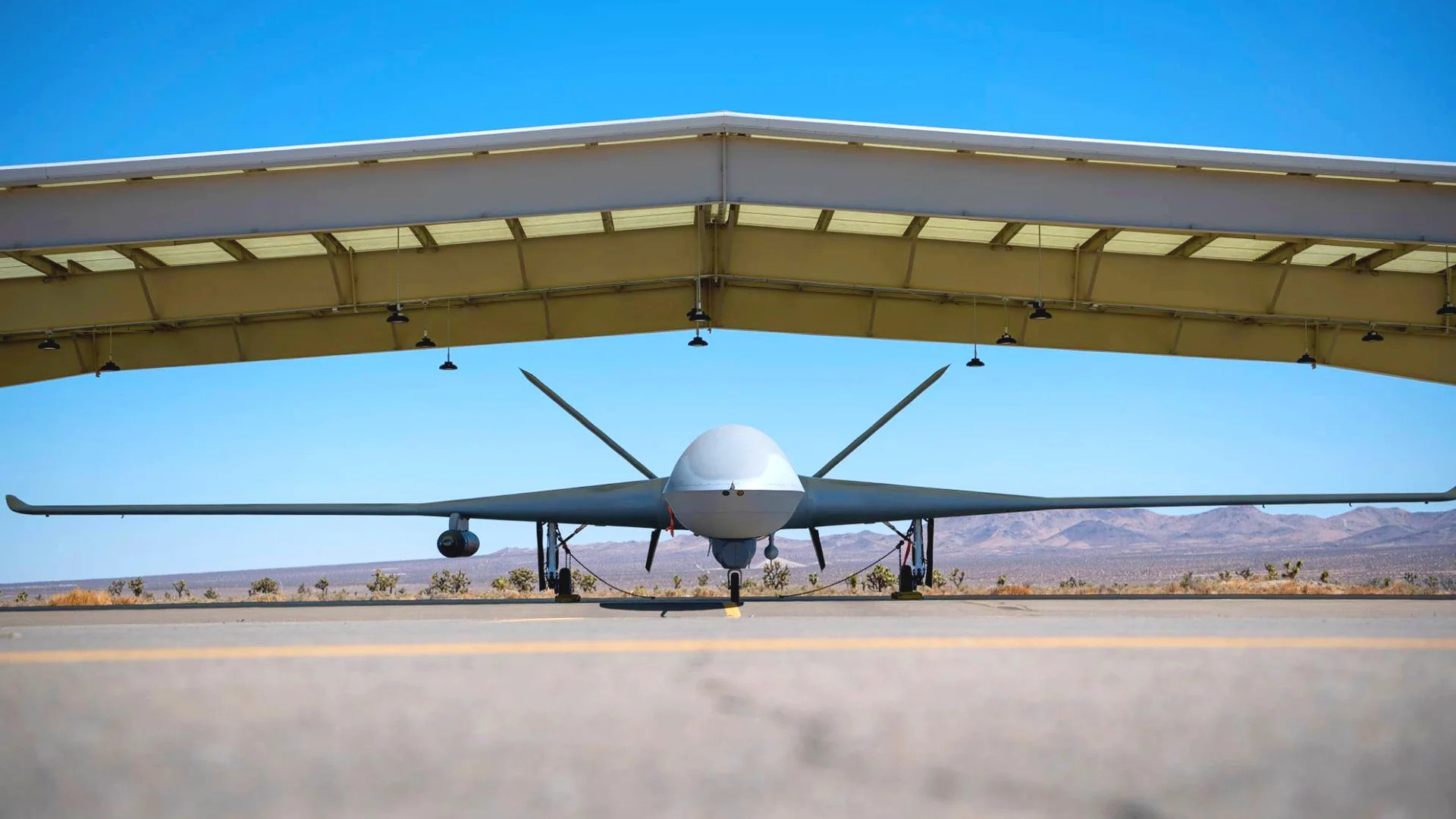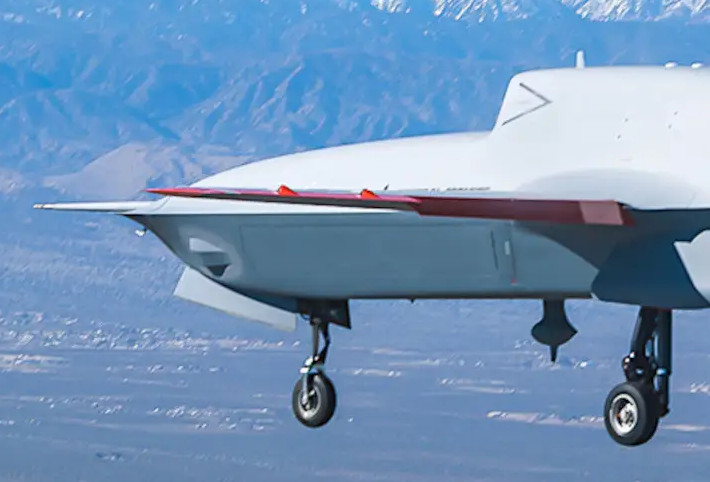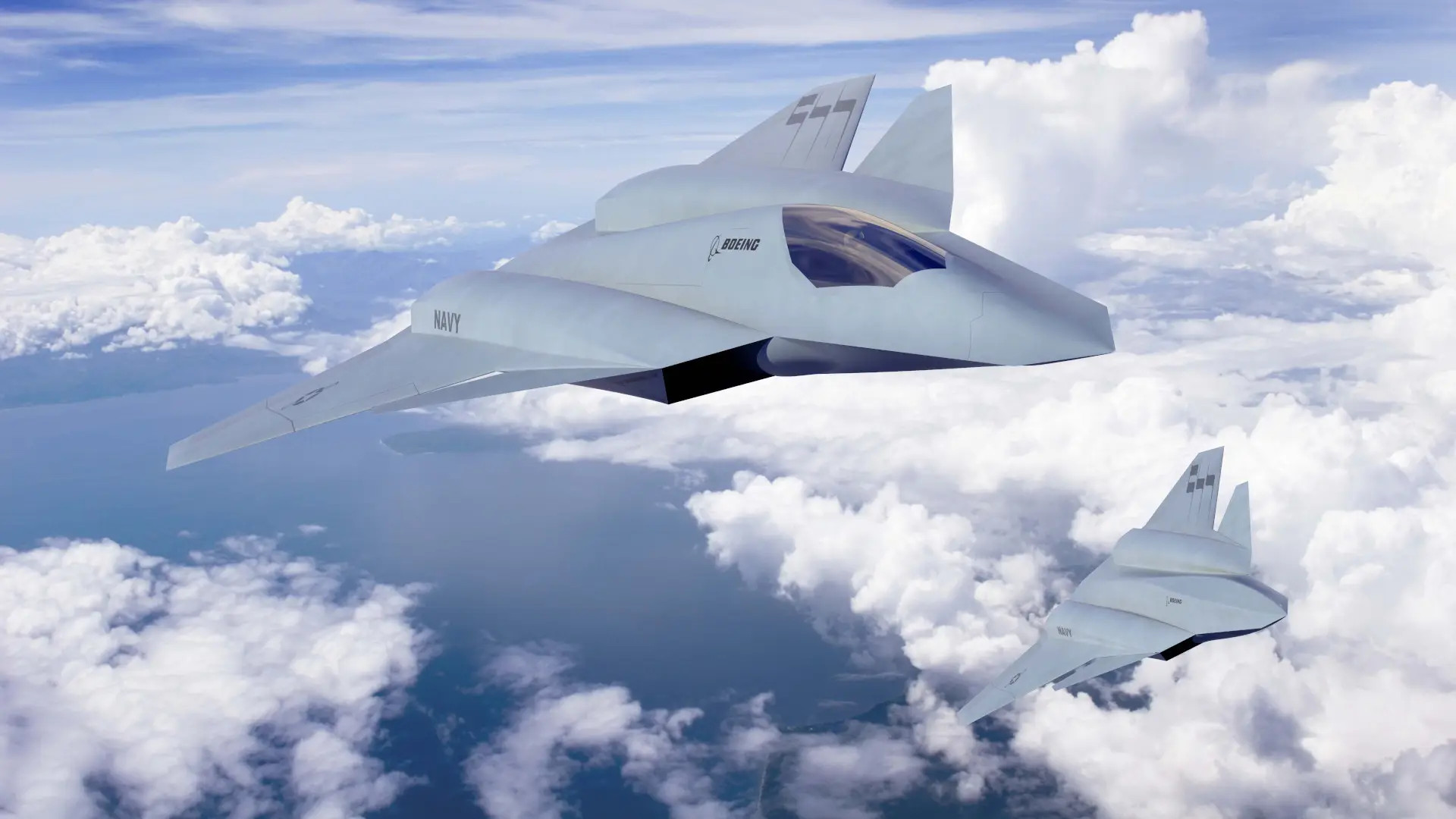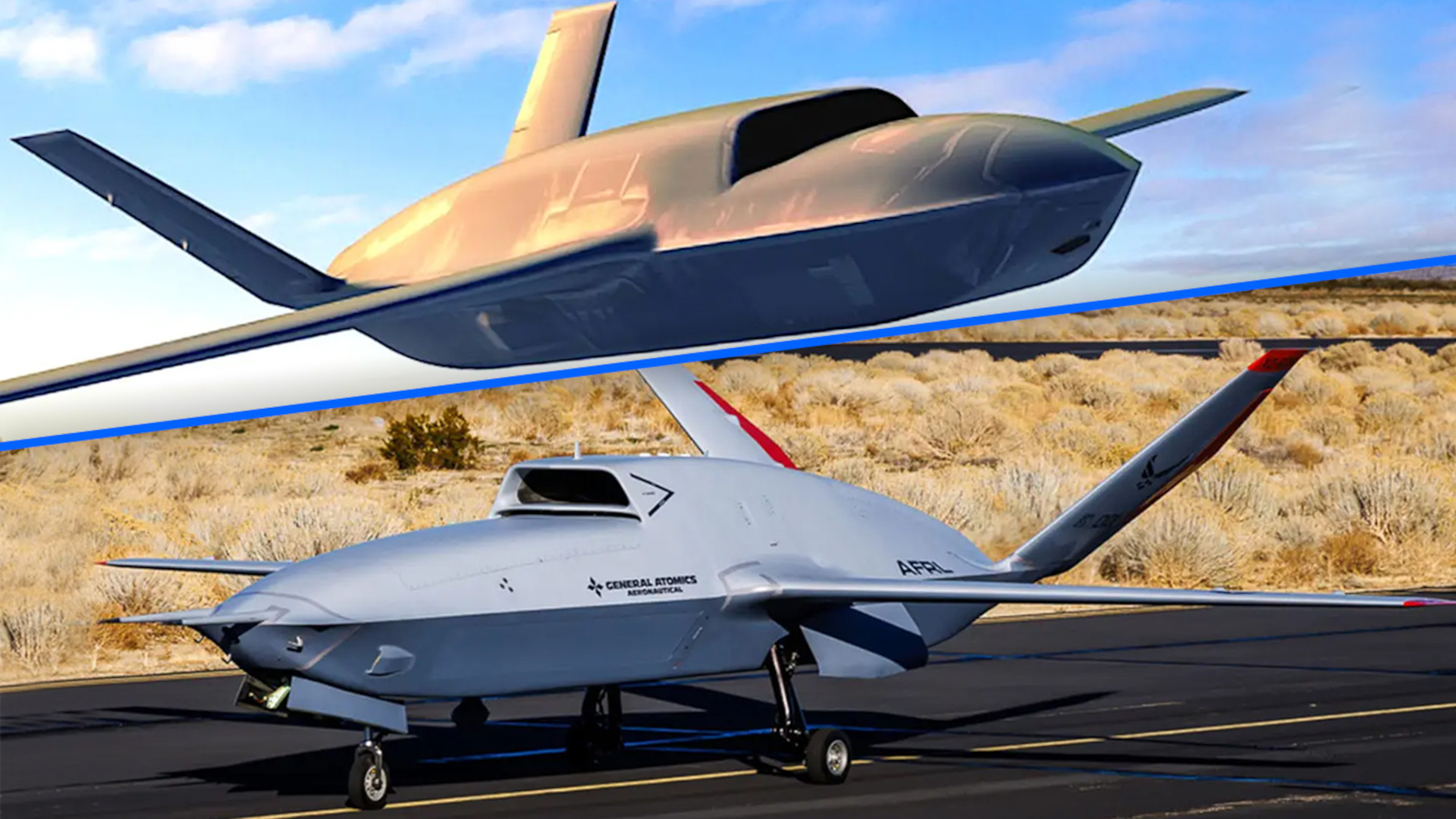General Atomics has now confirmed its experimental XQ-67A drone is indeed serving as the prototype for its Collaborative Combat Aircraft (CCA) design, one of two offerings that were recently down-selected by the U.S. Air Force. There are also additional indications that the company’s CCA drone, details about which were previously unknown, leverages work it is doing on the uniquely modular Gambit concept. The War Zone, which was the first to report on the XQ-67A, has repeatedly pointed in the past to signs that this drone, and potentially the secretive Air Force program it was developed under, were intertwined with the CCA effort.
The link between the XQ-67A and CCA design from General Atomics Aeronautical Systems, Inc. (GA-ASI) was formally laid out in a press release the company put out on April 24. This followed the Air Force’s announcement that it had chosen the company to move ahead in the first phase of the CCA program, also known as Increment 1. This initial stage of the CCA effort is expected to lead to further contracts, potentially worth billions of dollars, to build hundreds, if not thousands of drones. The CCA tender overall is seen as a transformative opportunity and the companies that get a head start on it could be better positioned than others to help shepherd the USAF into a new increasingly uncrewed era.
The XQ-67A was publicly unveiled in February and flew for the first time that month.

“Since then, this prototype for CCA [the XQ-67A] has successfully completed two additional test flights, laying the groundwork for a successful production and flight test program,” according to the company’s press release. “GA-ASI’s CCA production representative design is based upon the XQ-67A.”
The Air Force also selected Anduril, still a relative newcomer in the U.S. defense sector, but one that is quickly becoming a power player in transformational technological approaches, to move forward in CCA’s Increment 1. That company’s CCA offering is a version of Fury, a very different design from what General Atomics is working on. You can read more about Fury, and Anduril’s accompanying plans for disrupting traditional development and production practices, in much greater detail in this past The War Zone feature.
Three other companies that had received initial Increment 1 contracts – Boeing, Lockheed Martin, and Northrop Grumman – were cut, though the Air Force has made clear this does not preclude them from pursuing other future opportunities within the CCA program.
“It shares the same [tricycle] landing gear and primary structure with a slight change to the wing slope,” Aviation Week subsequently reported, citing information GA-ASI’s President David Alexander shared at the 2024 Army Aviation Mission Solutions Summit earlier this week.
“There are some slight differences between the two, but if you had them on the ramp 10 feet away, they look pretty similar,” Alexander said, according to Aviation Week.

This matches our previous analysis based on the XQ-67 and past General Atomics renderings. It also matches what we are seeing in a rendering of General Atomics’ CCA drone, shown at the top of this story, which the company put out along with its press release on Wednesday. In general terms, both designs are extremely similar, sharing a splayed v-tail, a top-mounted dorsal engine intake, and a chine line wrapping around the fuselage. The intake on the concept art looks more blended with the upper fuselage, as well as being lower-observable overall.
A trapezoidal window of the kind typically associated with a forward-facing electro-optical and/or infrared sensor system is also visible on the underside of the front of the nose in the rendering of the CCA design. This location would give whatever sensor might be concealed behind a largely fixed forward and downward field of view. Depending on how modular the design is in the end, it could be possible to rapidly swap out sensors and other systems in the nose and elsewhere to meet different mission demands.

The War Zone has long highlighted the possibility that CCA-like drones will be equipped with Infrared Search and Track (IRST) sensors, which can spot stealthy targets and offer other benefits, as part of their expected use in the air-to-air role. The Air Force envisions the first tranche of CCAs as starting out as weapons platforms working closely together with crewed combat jets, though other mission sets and more independent operations are expected to come down the line. The U.S. military’s general interest in IRST systems has grown significantly in recent years as the prospect of facing stealthy crewed and uncrewed aircraft, as well as cruise missiles, in future conflicts has become more pronounced.
General Atomics has already done significant testing using its stealthy Avenger drones to demonstrate potential air-to-air combat capabilities, including using podded IRST systems. Some of these test events have been complex and have demonstrated autonomy and artificial intelligence-enabled capabilities that are relevant to its CCA work.

“To complement the CCA contract, GA-ASI will continue to conduct a series of autonomy and mission system tests on the MQ-20 Avenger UAS [uncrewed aircraft system] and XQ-67A to accelerate the readiness of operational autonomy,” GA-ASI said in its press release earlier this week. “These live flight tests will continue to demonstrate the readiness of the full mission capability to support the emerging U.S. Air Force Autonomous Collaborative Platforms (ACP).”
To meet the Air Force’s requirements, such as they are known, it is highly probable that General Atomics’ CCA design has one or more internal payload bays. The War Zone has pointed out in the past that XQ-67A has what could be large side-looking airborne radar (SLAR) apertures on both sides of the forward fuselage, but that these could also be weapons bays. SLAR would make more sense for XQ-67A based on what we know of the Air Force’s separate and secretive Off-Board Sensing Station (OBSS) program under which the drone was developed. At the same time, the spaces along the sides of the forward fuselage could be modular or otherwise readily adaptable. Earlier this year, the Air Force also disclosed the existence of an Off-Board Weapon Station (OBWS) effort related to the OBSS project, as you can learn more about here.

Curiously absent from all of this discussion, at least explicitly, is General Atomics’ Gambit family, which was unveiled in 2022. The literal core of the Gambit concept is the use of a common central chassis with tricycle landing gear, along with its AI ‘brain,’ flight control system, and mission computer, onto which different airframe configurations can be readily mated.

To date, General Atomics has not drawn an explicit link between Gambit and the XQ-67A, or to its CCA offering. However, there are definite indications that all three development efforts are intertwined. The CCA rendering shows a drone that also looks very similar to Gambit concepts optimized for sensing and air-to-air combat that the company has previously shown, as can be seen in the video below.

An earlier rendering looks almost identical to what we are seeing today in the CCA concept art and the XQ-67A itself.

On top of that, General Atomics’ CCA press release highlights the role of “the XQ-67A CCA prototype aircraft” in validating the “‘genus/species’ concept pioneered by the Air Force Research Laboratory (AFRL) as part of the Low-Cost Attritable Aircraft Platform Sharing (LCAAPS) program” and that LCAAPS “focused on building several aircraft variants from a common core chassis.”
OBSS evolved from work done under LCAAPS and another project called the Low Cost Attritable Strike Demonstrator (LCASD), both of which spun off from a previous initiative called Low Cost Attritable Aircraft Technologies. LCASD notably birthed Kratos’ XQ-58A Valkyrie drone.
However all of the different General Atomics advanced drone efforts are or aren’t tied together, they give the company a running start in the new head-to-head competition with Anduril in Increment 1 of the CCA program. From what is known now, the OBSS project has many core objectives in line with the Air Force’s broader vision for CCA, and the XQ-67A offers a USAF-funded and already flying risk reduction demonstrator for the latter effort. General Atomics also has decades of experience in the development and serial production of other drones, with the USAF being its primary customer, including a still expanding number of variants and derivatives of the now iconic MQ-1 and MQ-9 families.
General Atomics has made no secret of its view that it is ideally positioned to be the prime contractor for the Air Force’s first tranche of CCAs, and to meet the service’s ambition schedule and production goals.

“This is in our wheelhouse. And we are, I don’t want to sound too cocky, we are the best in the world at it,” GA-ASI’s President Alexander told Aviation Week, adding he believed his company could beat the Air Force’s schedule requirements by as much as 50 percent.
Right now, the Air Force expects to pick a single initial CCA design under Increment 1 and to buy no less than 1,000 of those drones, and likely many more. The service’s stated goal is for the selected design to enter mass production no later than 2028 and for the first examples to enter operational service around the same time. CCA is part of the Air Force’s larger Next Generation Air Dominance (NGAD) initiative. A new sixth-generation crewed stealth combat jet is another one of NGAD’s subprograms and this aircraft is one of the platforms the CCA drones are expected to be partnered with in the future.
Overall, a consensus continues to build that disruptive changes to how aircraft are traditionally developed and produced will be needed for the Air Force’s CCA vision to become a reality, especially when it comes to meeting capability and force structure requirements while keeping costs down. Concerns have previously emerged from members of Congress about how the service is balancing its cost and capabilities goals for the CCA program. Secretary of the Air Force Frank Kendal has said the goal is for each drone to have a price tag between one-third and one-quarter of the unit price of an F-35 Joint Strike Fighter. This would be around $20.5 and $27.5 million based on publicly available information. With those unit prices, it would cost the Air Force Between $20.5 and $27.5 billion to buy 1,000 drones, not including developmental and other costs.
Increment 1 is also only the first of what are expected to be multiple iterative development cycles that could lead to the fielding of additional types of CCA drones in the future. The Air Force has also not ruled out the possibility of selecting multiple designs to go into production just in the first phase of the program.

Whatever design or designs are selected, it seems increasingly a given that a large subcontractor base will be necessary to produce the volume of drones the service is looking at acquiring in a reasonable timeframe. The Air Force’s press release earlier this week about the new Increment 1 contracts explicitly says that “the companies not selected … will continue to be part of the broader industry partner vendor pool consisting of more than 20 companies to compete for future efforts, including future production contracts.”
In the meantime, plans are already underway for Increment 2, which could kick off before the end of the year. This second CCA cycle could be the first to involve foreign participation in the program. The Air Force is already actively collaborating with other branches of the U.S. military on CCA-related developments. The service has been particularly actively engaged with the Navy on its separate, but intertwined carrier-based drone effort. The Air Force and the Navy envision a future where control of either service’s drones can be passed seamlessly back and forth during real-world operations.

Northrop Grumman, which was not picked to move ahead in Increment 1, has now said that it is keeping an eye out for ways to get back into the CCA program in the future. Boeing and Lockheed Martin have both pointed to other ongoing developments and opportunities in the wake of the Air Force not selecting them to advance, either, according to Air & Space Forces Magazine. Kratos, which did not receive an initial contract under Increment 1, has publicly said it is looking to compete in Increment 2. Various companies could consolidate their efforts, as well, joining forces to make a better case that they are up to the task of building hundreds of drones quickly and on budget.
General Atomics is clearly positioning itself as the top contender, at least to become the prime contractor for CCA’s Increment 1, with its existing work on XQ-67A and Gambit. On the other hand, Anduril, with its fresh take on weapons development and procurement, and its flexible and high-performance Fury drone competitor, will surely give them a run for their money, especially as changing not just the technology, but how the service does procurement business is such a huge facet of the CCA initiative.

There remains the possibility that the USAF will pick both General Atomics and Anduril’s designs. Seeing how different the two designs are, with performance deltas that may match their appearance, this very well could be the case. This would align with the pairing of the higher-performance OBWS concept with OBSS. The Air Force has not disclosed whether or not an actual drone is being developed, or has been already, as part of OBWS. It could be that General Atomics has yet another design up its sleeve, but we have no way of knowing that for certain at this time.
With all this in mind, competition for CCA development cycle tenders, as well as other related contracts, looks set to be fierce all around given the magnitude of the potential awards.
Contact the author: joe@twz.com
